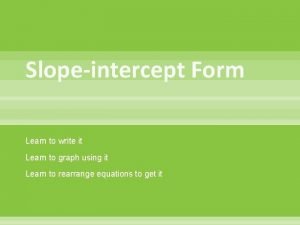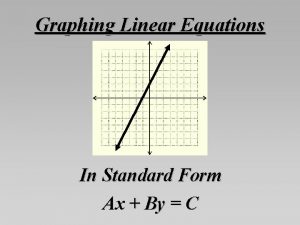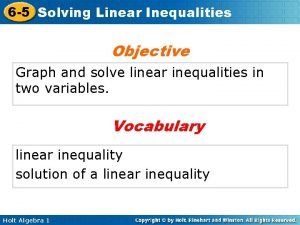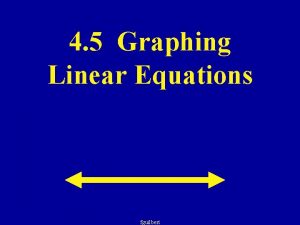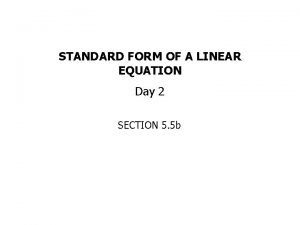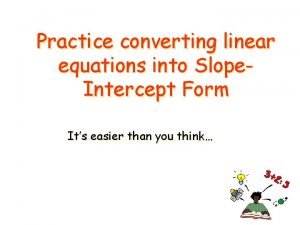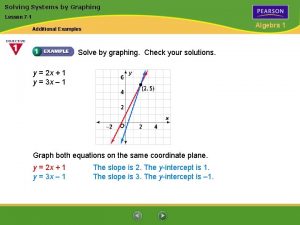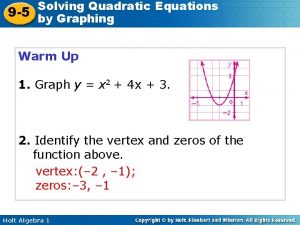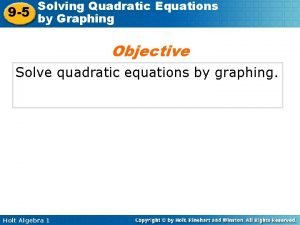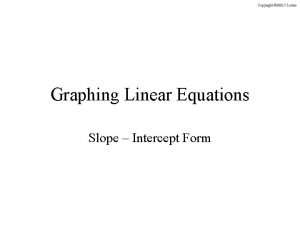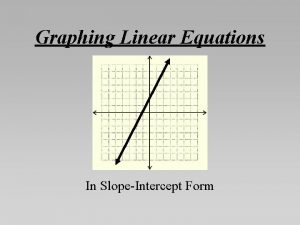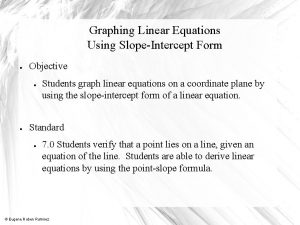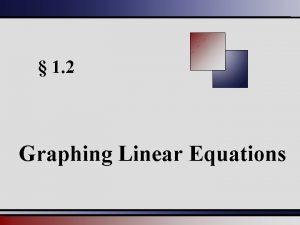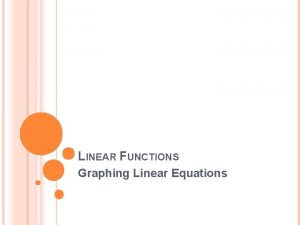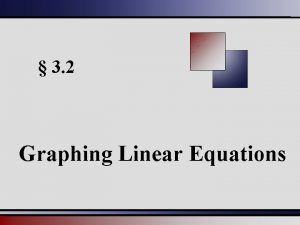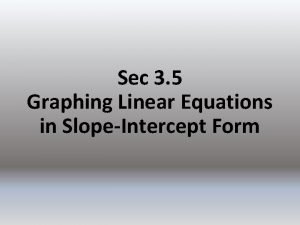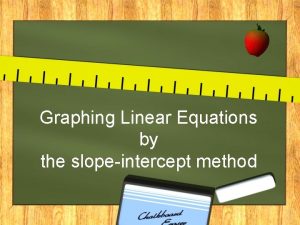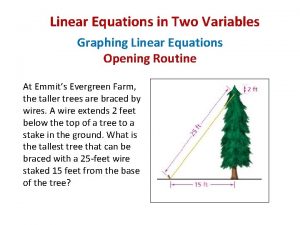Graphing Linear Equations in SlopeIntercept Form Notes 3
























- Slides: 24

Graphing Linear Equations in Slope-Intercept Form Notes 3. 5 Goals: • Find the slope of a line • Use the slope-intercept form of a linear equation • Use slopes & y-intercepts to solve real-life problems

Slope • 2 4

Slope •

Example 1: Finding the Slope of a Line Describe the slope of each line. Then find the slope using the formula. The slope rises from left to right. So, the slope is positive. a. ) 4 3

Example 1: Finding the Slope of a Line Describe the slope of each line. Then find the slope using the formula. b. ) (-3, 3) The slope falls from left to right. So, the slope is negative. 6 -4 (3, -1)

You try!

Example 2: Finding the Slope From a Table The points represented in the table lie on a line. How can you find the slope of the line from the table? What is the slope of the line? YOU CA a. ) CHOOS N E TWO P ANY FROM OINTS THE TA BLE AND U S E THE SLOPE FORM ULA! m = -2

Example 2: Finding the Slope From a Table The points represented in the table lie on a line. How can you find the slope of the line from the table? What is the slope of the line? b. ) m=0

Example 2: Finding the Slope From a Table The points represented in the table lie on a line. How can you find the slope of the line from the table? What is the slope of the line? c. ) The slope is undefined

You try! 4. ) The points represented by the table lie on a line. What is the slope of the line? x 2 4 6 8 y 10 15 20 25

Using the Slope-Intercept Form of a Linear Equation A linear equation written in the form y = mx + b is in slope-intercept form. The slope of the line is m and the y-intercept of the line is b. y = mx + b Slope y-intercept

Example 3: Identifying Slopes and y-Intercepts Find the slope and y-intercept of the graph of each linear equation. y = 3 x + (-4) a) y = 3 x – 4 Slope = 3 y intercept = -4 b) y = 6. 5 y = 0 x + 6. 5 Slope = 0 Y-intercept = 6. 5 c) -5 x – y = -2 +5 x - y = 5 x – 2 -1 -1 y = -5 x + 2 Slope = -5 y-intercept = 2

You try! Find the slope and y-intercept of the graph if the linear equations. Slope = -6 5. ) y = -6 x + 1 y-intercept= 1 6. ) y = 8 7. ) x + 4 y = -10 y = 0 x + 8 Slope = 0 y-intercept = 8

Example 4: Using Slope-Intercept Form to Graph •

Example 5: Graphing from a Verbal Description •

Example 5: Graphing from a Verbal Description a. ) A linear function g models a relationship in which the dependent variable increases 3 units for every 1 unit the independent variable increases. Graph g when g(0)=3. Identify the slope, y-intercept and xintercepts of the graph. Slope= 3 y-intercept: The statement g(0) = 3 indicates that when x=0, y=3. So, the y-intercept is 3.

Example 5: Graphing from a Verbal Description a. ) A linear function g models a relationship in which the dependent variable increases 3 units for every 1 unit the independent variable increases. Graph g when g(0)=3. Identify the slope, y-intercept and xintercepts of the graph. Slope= 3 y-intercept= 3 Graph: Plot the y-intercept and use the slope to find another point on the line.

Example 5: Graphing from a Verbal Description a. ) A linear function g models a relationship in which the dependent variable increases 3 units for every 1 unit the independent variable increases. Graph g when g(0)=3. Identify the slope, y-intercept and xintercepts of the graph. Slope= 3 y-intercept= 3 x-intercept: The line crosses the x-axis at (-1, 0). So, the x-intercept is -1.

You try! Graph the linear equation and identify the x-intercept. 8) y = 4 x – 4 Slope= 4 y-intercept= -4 The line crosses the x-axis at (1, 0). So, the x-intercept is 1. 9) x + 2 y = 6 y-intercept= 3 The line crosses the x-axis at (6, 0). So, the x-intercept is 6.

You try! •

Example 6: Solving Real-Life Problems In most real-life problems, slope is interpreted as rate, such as miles per hour, dollars per hour or people per year.

Example 6: Solving Real-Life Problems A submersible that is exploring the ocean floor begins to ascend to the surface. The elevation h (in feet) of the submersible is modeled by the function h(t) = 650 t – 13, 000, where t is the time (in minutes) since the submersible began to ascend. a) Graph the function and identify its domain and range. (see board) Domain: 0 < t < 20 Range: -13, 000 < h < 0

Example 6: Solving Real-Life Problems A submersible that is exploring the ocean floor begins to ascend to the surface. The elevation h (in feet) of the submersible is modeled by the function h(t) = 650 t – 13, 000, where t is the time (in minutes) since the submersible began to ascend. b) Interpret the slope and the intercepts of the graph. The slope is 650. So, the submersible ascends 650 feet per minute. The h-intercept is -13, 000. So, the elevation of the submersible at 0 minutes is -13, 000 feet. The t-intercept is 20. So, the submersible takes 20 minutes to reach an elevation of 0 feet (sea level).

You try! 11) The elevation of the submersible is modeled by h(t) = 500 t – 10, 000. a) Graph the function and identify its domain and range. b) Interpret the slope and intercepts of the graph.
 Slope-intercept form definition
Slope-intercept form definition Slopeintercept form
Slopeintercept form Slopeintercept form
Slopeintercept form Slopeintercept form
Slopeintercept form Ax+by=c
Ax+by=c 6-5 linear inequalities
6-5 linear inequalities 4-5 graphing linear equations
4-5 graphing linear equations Graphing linear equations definition
Graphing linear equations definition Lesson 5 - graphing linear equations and inequalities
Lesson 5 - graphing linear equations and inequalities Graphing linear equations vocabulary
Graphing linear equations vocabulary 4-1 practice graphing equations in slope intercept form
4-1 practice graphing equations in slope intercept form Persamaan linear simultan
Persamaan linear simultan Difference between linear and nonlinear equation
Difference between linear and nonlinear equation Metode gauss seidel
Metode gauss seidel Vertex form of a quadratic equation
Vertex form of a quadratic equation Standard form linear equation
Standard form linear equation Order and degree of differential equation ppt
Order and degree of differential equation ppt Intercept form of a parabola
Intercept form of a parabola Slope intercept form simplifier
Slope intercept form simplifier Absolute value variables
Absolute value variables Graphing systems of nonlinear equations
Graphing systems of nonlinear equations Lesson 7 solve systems of equations by graphing
Lesson 7 solve systems of equations by graphing 9-5 solving quadratic equations by graphing
9-5 solving quadratic equations by graphing 9-5 solving quadratic equations by graphing
9-5 solving quadratic equations by graphing Objectives of quadratic equation
Objectives of quadratic equation
